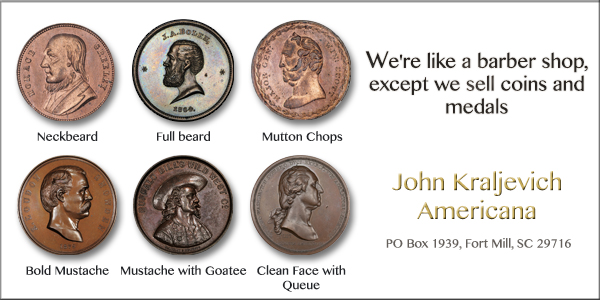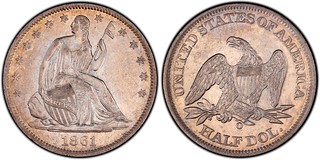
PREV ARTICLE
NEXT ARTICLE
FULL ISSUE
PREV FULL ISSUE
WHY THE CONFEDERATES STOPPED MINTING IN NEW ORLEANSPeter Bertram submitted these thoughts in
response to a phrase in Howard Berlin's recent report on his
visit to the museum at the old New Orleans mint. Thanks! Peter
sent his note last week but it somehow went astray and didn't
make it into the last issue. Sorry! I borrowed the coin image
from PCGSCoinFacts.com. -Editor
Under both Louisiana and Confederate authority (and using US dies on hand), the Mint did indeed strike half dollar coins for the Confederacy. They also struck four Confederate Half Dollars with a new Confederate reverse die. My quibble is with the “…quickly ran out of bullion” comment. This popular misconception has unfortunately been perpetuated for so many years that it has come to be accepted as fact. The actual explanation for the discontinuation has two reasons. The first was an April 12th, 1861 letter in which Treasury Secretary Memminger instructed New Orleans Mint Superintendent William Elmore to cease operations, writing - “...it is not probable that much coinage will be required, while it is certain that the Government will need the Bullion Fund for its necessities.” He also directed Elmore to - “..dismiss workman so as to leave the establishment merely property taken care of..”. The second reason was discontinuation of the new Confederate Half Dollar. The new reverse die for it had been prepared by New Orleans die sinker August H. M. Peterson (aka Patterson), but neither Peterson nor the Mint’s Chief Coiner Dr. B.F. Taylor had experience sinking coinage dies. As a result the depth of the engraving on the new die made it impossible to mount and strike coins with it in the Mint’s steam press. The two dies were thus placed in an old screw press and the four half dollars were struck by hand. This would obviously be a most inefficient coining procedure and was thus the end of the new Confederate half dollar coin. The four coins were given to officials and were not seen again until they started reappearing in 1879. Finally, lest there still be any doubt about “…quickly ran out of bullion”, we have the records of the Confederate assay office in Dahlonega, Georgia. After the Dahlonega Mint ceased coining operations in the Fall of 1861, Memminger, in response to Georgia gold mining interests, ordered the Mint to remain open as an assay office and bullion repository. In July of 1862 Assayer Lewis W. Quillian received the largest shipment the Dahlonega office would ever get - the bullion from the New Orleans Mint that had been sent out of the city ahead of invading Union forces. When assayed it amounted to some 17 gold bars and 196 silver bars! To read the earlier E-Sylum article, see:
 Wayne Homren, Editor The Numismatic Bibliomania Society is a non-profit organization promoting numismatic literature. See our web site at coinbooks.org. To submit items for publication in The E-Sylum, write to the Editor at this address: whomren@gmail.com To subscribe go to: https://my.binhost.com/lists/listinfo/esylum All Rights Reserved. NBS Home Page Contact the NBS webmaster 
|
